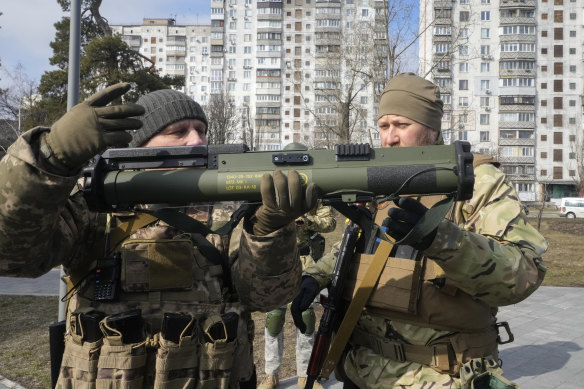
The fact these are central bank assets amplifies the concerns, given the centrality of central banks to the global financial system.
The Europeans have been concerned that targeting the underlying assets, rather than the income they generate, could jeopardise the euro’s status as a reserve currency, leading to an exodus of foreign capital from Europe and impacting European interest rates and inflation. It could also undermine Euroclear’s credibility and trust as a major clearing house – and a key component of the infrastructure of Europe’s financial system – for international securities transactions.

Ukraine desperately needs funds to halt Russia’s advances.Credit: AP
US Treasury Secretary Janet Yellen has played down those risks by making the point that there are no real alternatives as reserve currencies to the US dollar, the euro and Japan’s yen.
No rational Middle Eastern or developing economy central bank would be comfortable holding its reserves in China or Russia, although there is little doubt that, having experienced the weaponisation of the dollar and euro in response to the invasion, plenty of countries in the “Global South” and Middle East would like to have a viable alternative.
It is notable that, despite murmurs of discontent when the G7 responded to the invasion with the freezing of Russian assets held offshore, there has been no discernible shift of any consequence in global capital flows.
The Europeans are also worried, with good reason, that Russia will launch a blizzard of litigation in response and also target not just the €33 billion of assets Euroclear holds within Russia, which are already frozen, but funds in its securities depositaries in other jurisdictions. Euroclear has about €37 trillion of international assets on its platforms.
Euroclear doesn’t pay interest on those assets, so siphoning off the interest on Russia’s funds while leaving the underlying assets frozen but without any further threat to their ownership – they remain Russia’s property – is arguably a less vulnerable and less precedent-setting course.
Euroclear, which has generated more than €4.4 billion of profits on the Russian assets since the invasion, has kept that income at arm’s length from its normal operations.
Under the EU’s plan, Euroclear would retain about 3 per cent of the annual income from those assets to cover its operating costs and another 10 per cent to provide for the cost of the inevitable litigation. The rest – and the amounts would depend on the interest rates prevailing at the time – would go to Ukraine.
While the Kremlin has described the plan as “banditry and theft” and warned that those making the decisions would become the objects of prosecutions for decades, the EU is effectively taxing earnings that, because of the G7 (and Australia’s) decision to freeze Russia’s central bank reserves, would otherwise flow as windfall profits to the clearing house.
Loading
It’s a tax, albeit an extremely targeted one, rather than a confiscation. Euroclear itself has been wary of other plans to use Russia’s assets to help Ukraine, like using them as collateral for loans, but is broadly supportive of the current plan because the earnings on assets held by the clearing house legally belong to it.
The €3 billion or so a year that the EU envisages handing over to Ukraine might be a paltry amount when set against the €210 billion sitting on the Euroclear platform that the Ukrainians would love to get their hands on. Every little bit, however, will help in the desperate circumstances Ukraine finds itself in.
The Business Briefing newsletter delivers major stories, exclusive coverage and expert opinion. Sign up to get it every weekday morning.









 Add Category
Add Category